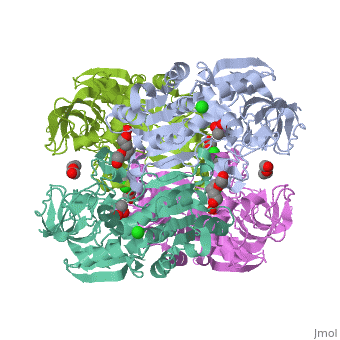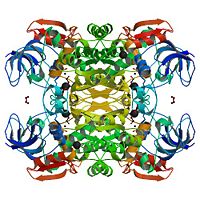Chimera of alcohol dehydrogenase by exchange of the cofactor binding domain res 153-295 of C. beijerinckii ADH by T. brockii ADH
From Proteopedia
| |||||||
| Chimera of alcohol dehydrogenase complex with etylene glycol, ethane diol, triethylene glycol, chloride and Zn+2 ions 3fpl | |||||||
|---|---|---|---|---|---|---|---|
| Ligands: | , , , , | ||||||
| Gene: | ADH1, ADH1 ("Clostridium rubrum" Ng and Vaughn 1963) | ||||||
| Activity: | Alcohol dehydrogenase (NADP(+)), with EC number 1.1.1.2 | ||||||
| Related: | 3fpc | ||||||
| |||||||
| |||||||
| Resources: | FirstGlance, OCA, RCSB, PDBsum | ||||||
| Coordinates: | save as pdb, mmCIF, xml | ||||||
Chimera Χ22(CTC) (3fpl)
The cofactor-binding domains (residues 153-295) of the alcohol dehydrogenases from the thermophile Thermoanaerobacter brockii (TbADH), the mesophilic bacterium Clostridium beijerinckii (CbADH), and the protozoan parasite Entamoeba histolytica (EhADH1) have been exchanged. Three chimeras have been constructed. In the first chimera, the cofactor-binding domain of thermophilic TbADH was replaced with the cofactor-binding domain of its mesophilic counterpart CbADH [chimera Chi21((TCT))]. This domain exchange significantly destabilized the parent thermophilic enzyme (DeltaT(1/2) = -18 degrees C). The reverse exchange in CbADH [chimera Chi22((CTC))], however, had little effect on the thermal stability of the parent mesophilic protein. Furthermore, substituting the cofactor-binding domain of TbADH with the homologous domain of EhADH1 [chimera Chi23((TET))] substantially reduced the thermal stability of the thermophilic ADH (DeltaT(1/2) = -51 degrees C) and impeded the oligomerization of the enzyme. All three chimeric proteins and one of their site-directed mutants were crystallized, and their three-dimensional (3D) structures were determined. Comparison of the 3D structures of the chimeras and the chimeric mutant with the structures of their parent ADHs showed no significant changes to their Calpha chains, suggesting that the difference in the thermal stability of the three parent ADHs and their chimeric mutants could be due to a limited number of substitutions located at strategic positions, mainly at the oligomerization interfaces. Indeed, stabilization of the chimeras was achieved, to a significant extent, either by introduction of a proline residue at a strategic position in the major horse liver ADH-type dimerization interface (DeltaT(1/2) = 35 degrees C) or by introduction of intersubunit electrostatic interactions (DeltaT(1/2) = 6 degrees C).
Biochemical and Structural Properties of Chimeras Constructed by Exchange of Cofactor-Binding Domains in Alcohol Dehydrogenases from Thermophilic and Mesophilic Microorganisms., Goihberg E, Peretz M, Tel-Or S, Dym O, Shimon L, Frolow F, Burstein Y, Biochemistry. 2010 Feb 9. PMID:20102159
From MEDLINE®/PubMed®, a database of the U.S. National Library of Medicine.
The NADP+-dependent alcohol dehydrogenases (EC 1.1.1.2) from the thermophile Thermoanaerobacter brockii (TbADH), the mesophilic bacterium Clostridium beijerinckii (CbADH), and the protozoan parasite Entamoeba histolytica (EhADH1) are [1] (monomers are colored in different colors) secondary alcohol dehydrogenases. Each of these alcohol dehydrogenases consists of two domains: the (residues 154−294 for TbADH) and the (residues 1−153 and 295−351 for TbADH; contains Zn2+ at the active site) separated by a deep cleft. Although, all these three ADHs revealed a high degree of sequence conservation (62-75% identity), them significantly differ in thermostability. The cofactor-binding domains (residues 153−295) of TbADH, CbADH, and EhADH1 were mutually and 3 corresponding chimeras were constructed. The cofactor-binding domain of thermophilic TbADH was replaced with the cofactor-binding domain of its mesophilic counterpart CbADH (chimera Χ21(TCT), 3fsr). This domain replacement significantly destabilized the parent thermophilic enzyme (ΔT1/2 = −18 °C). But the reverse exchange in CbADH (chimera Χ22(CTC), 3fpl), had little effect on the thermal stability of the parent mesophilic protein.
</StructureSection>
Reference
Biochemical and structural properties of chimeras constructed by exchange of cofactor binding domains in alcohol dehydrogenases from thermophilic and mesophilic microorganisms., Goihberg E, Peretz M, Tel-Or S, Dym O, Shimon LJ, Frolow F, Burstein Y.Biochemistry. 2010 Jan 26. Epub ahead of print
- (See also Tetrameric alcohol dehydrogenases)
- (See also Chimeres of alcohol dehydrogenases)
Categories: Thermoanaerobacter brockii, entamoeba histolytica | Burstein, Y. | Felix, F. | Goihberg, E. | Shimon, L. | Bacterial alcohol dehydrogenase | Chimera | Cytoplasm | Domain exchange | Metal-binding | Nadp | Oxidoreductase | Zinc | ISPC, Israel Structural Proteomics Center. | Peretz, M. | Tel-Or, S. | ISPC | Israel Structural Proteomics Center | Structural genomic



